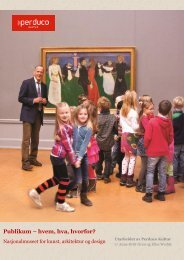Arts audiences: insight [PDF 6.5 MB] - Arts Council England
Arts audiences: insight [PDF 6.5 MB] - Arts Council England
Arts audiences: insight [PDF 6.5 MB] - Arts Council England
- No tags were found...
You also want an ePaper? Increase the reach of your titles
YUMPU automatically turns print PDFs into web optimized ePapers that Google loves.
A quiet pint with the match 8% of English adultsWith many of them approachingretirement or no longer working, Aquiet pint with the match are contentwith their lot in life and are not seekingchange. In their leisure time they likespending a lot of time at home, or youmight find them having a drink withfriends at their local.Their leisureThey occasionally go out for a drink at thepub, and many also enjoy fishing. Overall,however, they prefer a quiet night in togoing out and spend a lot of their free timeat home.They name watching TV as theirfavourite pastime, watching a range ofprogrammes – especially sport, soaps,game shows and quizzes.They also make time for reading the paperevery day, and many use the internetregularly in their leisure time.They are not particularly keen on shopping,typically picking up their necessities atIceland, Morrisons or Asda and makingsports-related purchases at Sports World.Their arts• attending arts events or participating inarts activities is not part of the currentlifestyle of this segment, and manyof them describe themselves as notinterested in ‘the arts’• they don’t go to arts events or do creativeactivities because they feel it’s not forthem, they think they would not enjoy it,and they prefer to do other things instead• they typically received a low level ofencouragement to attend and participatein the arts when youngEngaging with A quiet pintwith the match‘The arts’ are an unfamiliar concept for thisgroup and will need to be positioned as partof a broader leisure opportunity. Strategiesthat position arts engagement as a chanceto contribute to the local community, makeuse of their skills (eg manual or craft skills),or tell their story are likely to be moreeffective. <strong>Arts</strong> activities or experiencescould also be offered as support in difficulttimes, such as periods of poor health –partnerships with other providers could bekey in reaching this group.In all these cases it is important to keepthe tone of communications informaland unpatronising. For example, placecommunications in pubs, community venuesand local media. Communicating throughexisting local networks of neighbours,colleagues or friends is also likely to be aneffective way to engage with them.Their demographics• the majority of this group – two thirds –are men• typically older, with a quarter agedover 65• the majority live with a partner with nochildren in with household• typically have limited financial means, alow level of education and work/used towork in routine or semi-routine jobs –half of them are not currently working• more likely than average to live in thenorth of <strong>England</strong> (North East, NorthWest, Yorkshire)52 <strong>Arts</strong> <strong>audiences</strong>: <strong>insight</strong>


![Arts audiences: insight [PDF 6.5 MB] - Arts Council England](https://img.yumpu.com/45899288/52/500x640/arts-audiences-insight-pdf-65-mb-arts-council-england.jpg)



